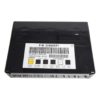Restore Your Cadillac’s Brain and Banish Electrical Gremlins
Is your 2010 Cadillac STS acting possessed? Flickering dash lights, windows with a mind of their own, or a security system that randomly prevents you from starting the car are classic signs of a failing Body Control Module (BCM). As a technician with over two decades of experience, I’ve seen how a faulty BCM can turn a luxury vehicle into a source of daily frustration. The BCM is the central command center for your car’s body electronics, and when it goes, it takes comfort, convenience, and reliability with it.
This isn’t just a replacement part; it’s a complete, hassle-free solution. We take a genuine OEM-quality Body Control Module and program it with the very latest GM software, specifically matched to your vehicle’s VIN. This means you can skip the expensive trip to the dealership for programming. You get a part that’s ready to be installed, restoring the precise functionality your Cadillac was built with. This is the definitive fix for those maddening, intermittent electrical issues.
A Technician’s Notebook: The Ghost in the Machine
A customer brought in his 2010 Cadillac STS complaining of a “haunted” car. The interior lights would pulse dimly at night, the radio would occasionally shut off, and he’d sometimes get a “Service Theft System” message. He’d already replaced the battery, but the problems persisted. My diagnostic scan tool showed multiple communication loss codes with various modules. From experience, this pointed directly to the network’s hub: the BCM. After confirming power and ground to the module were solid, we knew the internal circuitry was failing. We installed a VIN-programmed BCM, performed the quick post-install relearns, and all the ghostly electrical issues vanished. The customer was thrilled to have his reliable, predictable luxury car back.
Is Your Cadillac Experiencing These Electrical Issues?
- ✔ Intermittent or non-functional power windows, locks, or mirrors.
- ✔ Erratic interior or exterior lighting behavior.
- ✔ False “Service Theft System” or other security-related warnings on the dash.
- ✔ A vehicle that won’t start, even with a good battery and starter.
- ✔ Unresponsive key fob or remote start functions.
- ✔ Gauges on the instrument cluster behaving erratically or not working at all.
Your Straightforward BCM Installation Guide
Installing your new 2010 STS Body Control Module is a manageable job for a confident DIYer. The BCM on the STS is located in the center dash area. Always consult a vehicle-specific repair manual for detailed diagrams.
- Safety First: Disconnect the negative terminal from your vehicle’s battery and wait at least 10 minutes to allow capacitors to discharge.
- Access the Module: Carefully remove the necessary dash trim panels to gain access to the BCM. On the 2010 STS, this is typically in the center dash console area.
- Disconnect and Remove: Unplug the electrical connectors from the old BCM. They have locking tabs, so be gentle. Once disconnected, unbolt or unclip the old module and remove it from the vehicle.
- Install the New BCM: Mount your new, pre-programmed BCM in the same location and securely fasten it. Reconnect all electrical connectors, ensuring they click firmly into place.
- Reassemble: Reinstall the dash trim panels you removed.
- Reconnect Power: Reconnect the negative battery terminal.
- CRITICAL Final Steps: After installation, you MUST perform two key procedures with a compatible high-end scan tool: the ‘Setup SDM Primary Key in BCM’ to ensure the airbag system communicates correctly, and a ‘Brake Pedal Position Sensor Calibration’. Failure to do so can leave you with an airbag warning light and improper brake light function.
Verified Fitment for Your GM Vehicle
This Body Control Module is a direct replacement for a wide range of GM vehicles. Please verify your vehicle and part number below. This unit is a guaranteed replacement for the following part numbers:
Interchangeable Part Numbers: 10382479, 15093910, 15276271, 15299986, 15819552, 15828601, 15837419, 15872388, 15872421, 15880684, 15921352, 15921353, 15948438, 15948439, 20815898, 20839063, 20864767, 20864768, 20921435, 20921436, 20935349, 22860591, 25826124, 25826125, 25847588, 25847589, 25892622, 25910474, 25934762, 25934763, 95151084
Compatible Models Include (but not limited to):
- Cadillac STS (2010)
- Cadillac CTS (2008-2013)
- Cadillac DTS (2006-2011)
- Cadillac Escalade, ESV, EXT (2010)
- Chevrolet Impala (2006-2013)
- Chevrolet Tahoe & Suburban 1500 (2010)
- GMC Acadia (2007-2012)
- GMC Yukon & Yukon XL 1500 (2010)
- Chevrolet Express & GMC Savana Vans (Various Years)
- And many more listed in the original fitment data.
Frequently Asked Questions
Why do you need my VIN to sell me this part?
Your Vehicle Identification Number (VIN) allows us to program the BCM with the exact software and vehicle-specific options your car came with from the factory. This ensures perfect compatibility and function, saving you a costly programming fee at the dealership.
Is this a simple plug-and-play installation?
It is a direct physical replacement, but it is not entirely plug-and-play. After installation, critical safety procedures like the airbag system key setup and brake pedal sensor calibration must be performed with a professional-grade scan tool to ensure everything works correctly and safely.
How do I find the BCM in my 2010 Cadillac STS?
In the 2010 STS, the Body Control Module is located behind the trim panels in the center dash console area. You will need to remove some trim to access it.
What happens if I skip the post-installation procedures?
Skipping the ‘Setup SDM Primary Key’ and ‘Brake Pedal Calibration’ is not recommended. You will likely have a persistent airbag warning light on your dash, and your brake lights may not function correctly, which is a major safety hazard.
Will this programmed 2010 STS Body Control Module fix my no-start problem?
If your no-start issue is caused by the factory anti-theft system being triggered by a faulty BCM, then yes, this part is very likely the solution. However, no-start conditions can have many causes, so proper diagnosis is always recommended.


